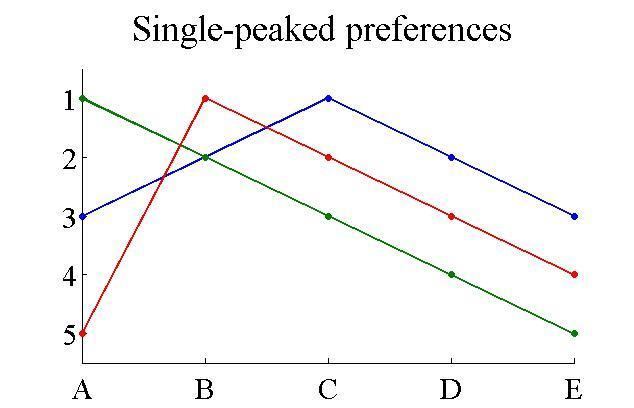 | ||
Single-peaked preferences are a kind of preference relations. A group of agents is said to have single-peaked-preferences if:
Contents
- Each agent has an ideal choice in the set; and
- For each agent, outcomes that are further from his ideal choice are preferred less.
Single-peaked preferences are typical of one-dimensional domains. A typical example is when several consumers have to decide on the amount of public good to purchase. The amount is a one-dimensional variable. Usually, each consumer decides on a certain quantity which is best for him, and if the actual quantity is more/less than that ideal quantity, the agent is then less satisfied.
With single-peaked preferences, there is a simple truthful mechanism for selecting an outcome: it is to select the median quantity. See the median voter theorem. It is truthful because the median function satisfies the strong monotonicity property.
Formal definition
Take an ordered set of outcomes:
In words,
Some examples
The following graphs show three preferences that are single-peaked over outcomes {A,B,C,D,E}. On the vertical axis, the number represents the preference ranking of the outcome, with 1 being most preferred. Two outcomes that are equally preferred have the same ranking.
The following graph gives two examples of preferences that are not single-peaked. The blue preferences are clearly not single-peaked because the preference ranking spikes down for "D" and then spikes up for "E". The green preferences are not single-peaked because they have two outcomes that are the most preferred: "B" and "C". Such preferences are sometimes called single-plateaued.
Interpretations
Single-peaked preferences have a number of interpretations for different applications.
A simple application of ideological preferences is to think of the outcome space
The outcome space can also be thought as different policies in an ideological spectrum: policies from the Left vs policies from the Right; policies that are more liberal vs policies that are more conservative; policies that are pro free markets vs policies that are pro state intervention. Voters have single-peaked preferences if they have an ideal balance between the two directions of the ideological spectrum and if they dislike policies the farther away they are from their ideal point.
